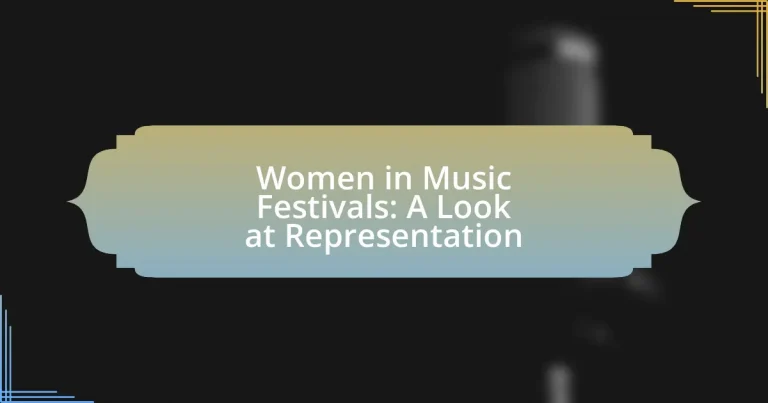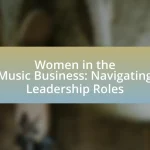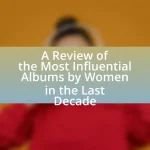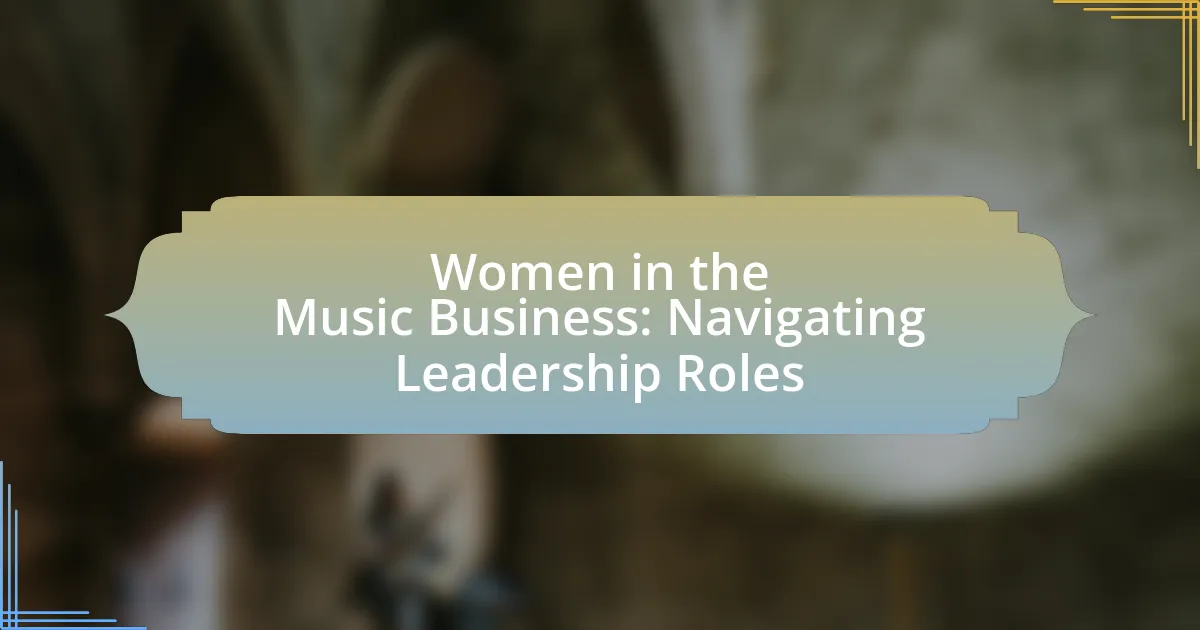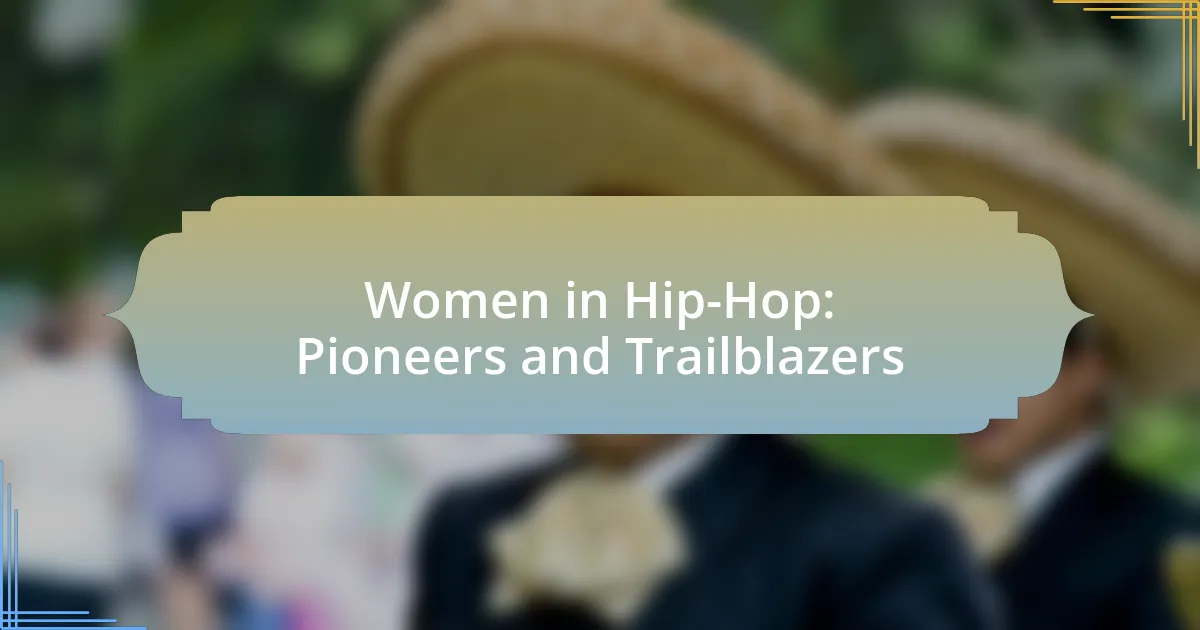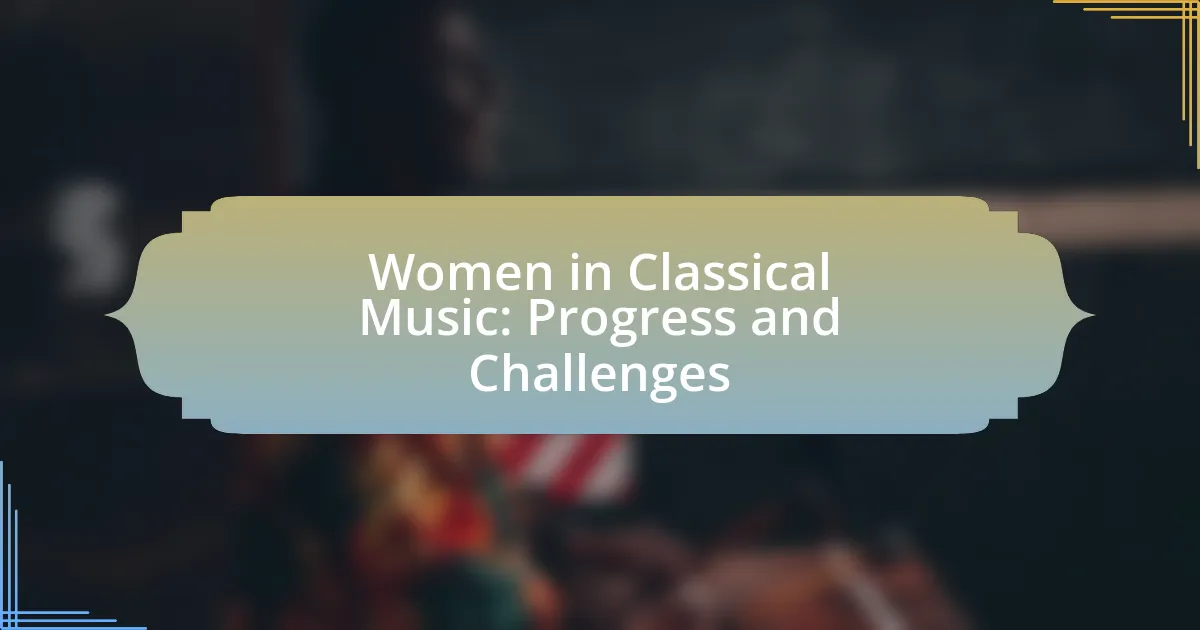The article examines the significance of women in music festivals, highlighting their crucial role in enhancing diversity and representation within the music industry. It discusses the evolution of women’s representation over time, noting historical milestones such as the Lilith Fair and the rise of female headliners at major festivals. The article also addresses the challenges women face, including safety concerns and industry biases, while outlining initiatives aimed at promoting gender equality, such as the Keychange pledge. Additionally, it emphasizes the importance of audience support and the impact of diverse lineups on festival success and overall industry growth.

What is the significance of women in music festivals?
Women play a crucial role in music festivals by enhancing diversity and representation within the music industry. Their presence not only challenges gender stereotypes but also promotes inclusivity, as evidenced by studies showing that festivals with female artists attract a more diverse audience. For instance, a report by the UK Music organization highlights that female performers can increase ticket sales and audience engagement, demonstrating their economic impact. Furthermore, the visibility of women in these events inspires future generations of female musicians, fostering a more equitable music landscape.
How has the representation of women evolved in music festivals over time?
The representation of women in music festivals has significantly evolved from minimal visibility to increased prominence and diversity. Historically, women were often underrepresented on festival lineups, with events predominantly featuring male artists; for example, in the 2010s, women made up only about 20% of performers at major festivals like Coachella. However, recent years have seen a shift, with festivals actively promoting gender equality and featuring female headliners such as Beyoncé and Billie Eilish, who have headlined major events. This change is supported by initiatives like the Keychange pledge, which encourages festivals to achieve a 50/50 gender balance by 2022. As a result, the representation of women in music festivals has transitioned from marginalization to a more equitable and celebrated presence.
What historical milestones have marked women’s presence in music festivals?
The historical milestones that have marked women’s presence in music festivals include the first all-female music festival, the 1997 Lilith Fair, which showcased female artists and aimed to promote gender equality in the music industry. Additionally, the introduction of female headliners at major festivals, such as Beyoncé at Coachella in 2018, represented a significant shift in representation, as she became the first Black woman to headline the festival. Furthermore, the establishment of initiatives like the “Keychange” campaign, which promotes gender balance in music festivals, has further highlighted the importance of women’s representation in this space. These milestones collectively demonstrate the evolving role and recognition of women in music festivals over the years.
How do cultural shifts influence women’s representation in these events?
Cultural shifts significantly enhance women’s representation in music festivals by challenging traditional gender norms and promoting inclusivity. For instance, the rise of feminist movements and increased awareness of gender equality have led to more female artists being booked for major festivals, as seen in events like Coachella, which featured a record number of female headliners in recent years. Additionally, studies indicate that festivals with diverse lineups attract larger audiences, further incentivizing organizers to prioritize gender balance. This shift not only empowers women in the industry but also reflects broader societal changes towards equality and representation.
Why is representation important in music festivals?
Representation is important in music festivals because it ensures diverse voices and perspectives are heard, fostering inclusivity and equality. When women and underrepresented groups are featured prominently, it challenges stereotypes and promotes a more balanced industry. Studies show that festivals with diverse lineups attract wider audiences and enhance the overall experience, as seen in events like Coachella and Glastonbury, which have made concerted efforts to include more female artists. This not only empowers marginalized artists but also inspires future generations, creating a more equitable music landscape.
What impact does female representation have on festival audiences?
Female representation significantly enhances festival audiences by fostering inclusivity and diversity. Research indicates that festivals featuring a higher percentage of female artists attract more diverse audiences, including increased attendance from women and underrepresented groups. For instance, a study by the University of Southern California found that festivals with balanced gender lineups saw a 30% increase in female attendees compared to those with predominantly male lineups. This shift not only enriches the audience experience but also promotes a sense of belonging and empowerment among women, ultimately leading to a more vibrant and engaged festival atmosphere.
How does diversity in lineups affect the music industry as a whole?
Diversity in lineups positively affects the music industry by fostering inclusivity, broadening audience engagement, and enhancing creativity. When music festivals and events feature diverse artists, they attract a wider demographic, which can lead to increased ticket sales and greater overall attendance. For instance, a study by the Annenberg Inclusion Initiative found that festivals with diverse lineups saw a 20% increase in attendance compared to those with less diversity. Additionally, diverse representation encourages innovation in music styles and collaborations, enriching the cultural landscape of the industry. This shift not only reflects societal changes but also drives economic growth within the music sector.

What challenges do women face in music festivals?
Women face several challenges in music festivals, including safety concerns, gender discrimination, and lack of representation. Safety issues often manifest as harassment or assault, with studies indicating that nearly 50% of women report experiencing harassment at music events. Gender discrimination is evident in the underrepresentation of female artists on festival lineups, where women comprise only about 20% of performers on average. Additionally, women often encounter barriers in accessing opportunities for networking and career advancement within the industry, further exacerbating the challenges they face in these environments.
What barriers exist for female artists in gaining festival slots?
Female artists face several barriers in gaining festival slots, including gender bias, lack of representation in lineups, and systemic inequalities within the music industry. Research indicates that music festivals often prioritize male artists, with a 2020 study by the UK-based organization Keychange revealing that only 23% of artists performing at major festivals were women. Additionally, female artists frequently encounter challenges such as limited networking opportunities and fewer industry connections, which can hinder their visibility and access to festival bookings. These barriers contribute to a cycle of underrepresentation, making it difficult for female artists to secure performance slots at festivals.
How do industry biases affect women’s opportunities in music festivals?
Industry biases significantly limit women’s opportunities in music festivals by favoring male artists in lineups, booking decisions, and promotional efforts. Research indicates that women represent only about 20% of performers at major music festivals, reflecting a systemic preference for male acts. This disparity is often perpetuated by stereotypes that suggest male artists are more commercially viable or appealing to festival audiences. Additionally, women face challenges such as unequal access to networking opportunities and industry resources, further hindering their visibility and participation in these events. Studies, including those from the Annenberg Inclusion Initiative, highlight that these biases not only affect the representation of women on stage but also influence the overall culture of music festivals, creating an environment that often sidelines female talent.
What role does sponsorship play in supporting female artists at festivals?
Sponsorship plays a crucial role in supporting female artists at festivals by providing financial resources and visibility that enable their participation and promotion. Financial backing from sponsors allows festivals to book more female artists, addressing gender disparities in lineups, which have historically favored male performers. For instance, a study by the Annenberg Inclusion Initiative found that only 22.5% of artists on festival lineups were women, highlighting the need for targeted sponsorship to enhance representation. Additionally, sponsorship can facilitate mentorship programs and workshops specifically for female artists, fostering their professional development and networking opportunities within the industry.
How do safety and harassment issues impact women’s experiences at festivals?
Safety and harassment issues significantly diminish women’s experiences at festivals by creating an environment of fear and discomfort. Research indicates that 73% of women have experienced harassment at music festivals, leading to increased anxiety and decreased enjoyment of the event. This pervasive issue often results in women feeling unsafe, which can deter their attendance and participation in future festivals. Furthermore, the lack of adequate security measures and support systems exacerbates these feelings, as many women report that they do not feel comfortable reporting incidents of harassment. Consequently, these factors contribute to a culture that marginalizes women’s presence and participation in the festival scene.
What measures are being taken to improve safety for women at music festivals?
Measures being taken to improve safety for women at music festivals include the implementation of enhanced security protocols, the establishment of dedicated safe spaces, and the provision of training for staff on harassment prevention. Enhanced security protocols involve increased presence of security personnel, particularly in areas where women congregate, and the use of surveillance technology to monitor activities. Dedicated safe spaces offer women a refuge to report incidents or seek assistance, ensuring they feel secure. Additionally, training for staff focuses on recognizing and addressing harassment, which has been shown to reduce incidents at events, as evidenced by studies indicating that well-trained staff can effectively intervene in potentially harmful situations.
How can festival organizers create a more inclusive environment for women?
Festival organizers can create a more inclusive environment for women by implementing gender-balanced lineups and ensuring equal representation in all festival roles, including performers, speakers, and staff. Research indicates that festivals with diverse lineups attract a wider audience and foster a more welcoming atmosphere. For instance, a study by the University of Southern California found that events featuring female artists not only increased attendance but also enhanced the overall experience for attendees, particularly women. Additionally, providing safe spaces, offering workshops on gender equality, and actively promoting female talent can further contribute to an inclusive environment.
What initiatives are promoting women’s representation in music festivals?
Initiatives promoting women’s representation in music festivals include the Keychange initiative, which aims for gender parity in festival lineups by 2022, and the ReBalance program, which supports female artists and industry professionals through funding and mentorship. Keychange has over 200 festivals committed to achieving a 50/50 gender balance, demonstrating a significant movement towards inclusivity. Additionally, organizations like SheFest and Girls Rock Camp provide platforms for female musicians, fostering talent and visibility in the industry. These initiatives collectively contribute to increasing the presence and recognition of women in music festivals.
How are organizations advocating for gender equality in music festivals?
Organizations are advocating for gender equality in music festivals by implementing initiatives that promote female artists and ensure equitable representation on stage. For instance, festivals like Glastonbury and Coachella have committed to increasing the number of female performers, with Glastonbury achieving a lineup that was 50% female in 2021. Additionally, organizations such as Keychange encourage festivals to pledge to achieve gender parity by 2022, resulting in over 200 festivals worldwide committing to this goal. These efforts are supported by research indicating that diverse lineups not only enhance audience experience but also contribute to the overall success of the festival.
What successful programs have been implemented to support female artists?
Successful programs that have been implemented to support female artists include initiatives like the “Women in Music” organization, which provides networking opportunities, mentorship, and educational resources specifically for women in the music industry. Additionally, the “She Rocks Awards” celebrates the achievements of female musicians and industry professionals, fostering visibility and recognition. Programs such as “Girls Who Code” in music technology also empower young women by teaching them skills in music production and sound engineering. These programs have been effective in increasing representation and support for female artists, as evidenced by the growing number of women participating in music festivals and industry events.
How do mentorship and networking opportunities enhance women’s visibility in festivals?
Mentorship and networking opportunities significantly enhance women’s visibility in festivals by providing them with essential support, resources, and connections that facilitate their participation and recognition. These opportunities allow women to build relationships with industry leaders, gain insights into the festival circuit, and access platforms that showcase their talents. For instance, programs like SheFest and Women in Music have been shown to increase female representation on stage and in leadership roles at festivals, leading to a more balanced and diverse lineup. Research indicates that festivals with mentorship initiatives report higher rates of female artist bookings, demonstrating a direct correlation between these opportunities and women’s visibility in the music festival landscape.
What role do audiences play in supporting women at music festivals?
Audiences play a crucial role in supporting women at music festivals by actively engaging with and promoting female artists. When audiences choose to attend performances by women, they contribute to the visibility and success of these artists, which can lead to increased opportunities for women in the music industry. For instance, a study by the University of Southern California found that festivals with higher female attendance and support for female acts often see a more diverse lineup in subsequent years, indicating that audience preferences can influence festival programming. This demonstrates that audience support not only empowers women artists but also fosters a more inclusive music festival environment.
How can festival-goers advocate for more female representation in lineups?
Festival-goers can advocate for more female representation in lineups by actively engaging with festival organizers through petitions, social media campaigns, and direct communication. For instance, studies show that festivals with diverse lineups attract larger audiences and enhance the overall experience, indicating that increased female representation can benefit both attendees and organizers. By voicing their preferences and supporting female artists, festival-goers can influence booking decisions and promote a more inclusive music scene.
What actions can fans take to support female artists during festivals?
Fans can support female artists during festivals by actively attending their performances, promoting their music on social media, and purchasing merchandise. By attending shows, fans contribute to the visibility and success of female artists, as attendance numbers often influence future bookings and opportunities. Promoting their music on platforms like Instagram and Twitter helps increase their reach and fanbase, which is crucial in an industry where visibility can lead to more significant opportunities. Additionally, purchasing merchandise directly supports the artists financially, allowing them to continue creating music and performing. According to a report by the Annenberg Inclusion Initiative, female artists are often underrepresented in festival lineups, making fan support even more critical for their success and visibility in the music industry.
What are some best practices for improving women’s representation in music festivals?
To improve women’s representation in music festivals, organizers should implement gender-balanced lineups, actively promote female artists, and establish mentorship programs. Gender-balanced lineups ensure equal opportunities for male and female performers, as evidenced by studies showing that festivals with diverse lineups attract larger audiences and enhance overall festival experience. Actively promoting female artists through marketing and social media campaigns increases visibility and encourages attendance, as seen in festivals that prioritize female headliners. Establishing mentorship programs connects emerging female artists with industry veterans, fostering talent development and retention, which is crucial for long-term representation in the music scene.
How can festival organizers ensure a balanced lineup?
Festival organizers can ensure a balanced lineup by actively promoting gender diversity and inclusivity in their artist selection process. This can be achieved by setting specific quotas for female artists and underrepresented groups, thereby addressing historical imbalances in festival lineups. Research indicates that festivals with diverse lineups not only attract a wider audience but also enhance the overall experience, as seen in events like Glastonbury, which has made concerted efforts to include more female performers. Additionally, organizers can collaborate with organizations that advocate for women in music, such as She Said So, to identify and book talent, ensuring a more equitable representation.
What strategies can be employed to foster a supportive community for women in music festivals?
To foster a supportive community for women in music festivals, organizers can implement mentorship programs that connect emerging female artists with established professionals in the industry. These programs can provide guidance, networking opportunities, and a sense of belonging, which are crucial for women navigating a male-dominated space. Research indicates that mentorship significantly enhances career development and confidence among women in various fields, including music. Additionally, creating safe spaces and designated areas for women at festivals can encourage open dialogue and support, further promoting inclusivity. Studies show that environments designed for specific demographics can lead to increased participation and satisfaction, reinforcing the importance of tailored approaches in community building.
